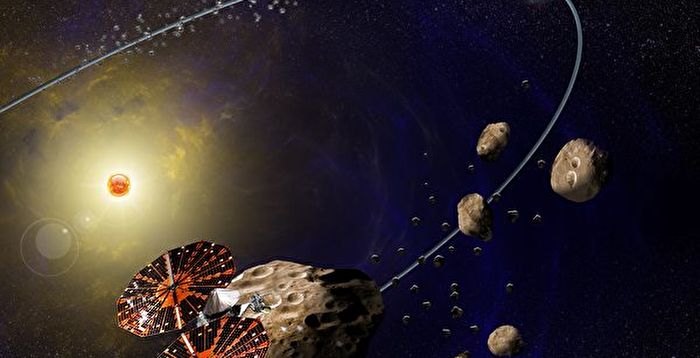[Epoch Times October 15, 2021](Epoch Times reporter Di Rui compiled a report) On October 16th (Saturday), NASA’s Lucy probe will be launched into space. The live video can be watched through NASA’s application software, their official website and YouTube channel.
The Lucy probe is worth 450 million U.S. dollars and is one of NASA’s largest exploration projects this year. It will explore eight asteroids in the next 12 years, including the Trojans around Jupiter’s orbit.
This is the first time humans have visited this asteroid group up close. The Trojan asteroid group is divided into two parts, located at 60 degrees before and after Jupiter’s orbit, and orbiting the sun with Jupiter. The astronomers who first discovered them named them with characters from the Trojan War in the “Iliad”, so the asteroids in it are collectively referred to as “Trojan Asteroids.” Because they follow Jupiter’s motion closely, some people call them “Jupiter’s children”.
Scientists believe that the Trojan asteroid group is like the “fossils” left by the solar system in the long process of evolution, containing important clues about 4.5 billion years ago and the early formation of the solar system. The mission is expected to end in 2033.
The Lucy probe will take off from the Kennedy Space Center in Florida at 5:34 a.m. Eastern Daylight Time (EDT) on the Atlas V carrier rocket. In case of bad weather, the launch will be delayed until October 17. The live broadcast will start at 5 o’clock.
The main itinerary of the Lucy detector includes:
• April 20, 2025: Visit the asteroid 52246 (Donaldjohanson) in the asteroid belt between Mars and Jupiter;
• August 12, 2027: Visit the first asteroid in the Trojan asteroid group-asteroid 3548 (3548 Eurybates), and a small satellite named Queta next to it;
• September 15, 2027: Visit the asteroid 15094 (15094 Polymele);
• April 18, 2028: Visit the asteroid 11351 (11351 Leucus);
• November 11, 2028: Visit the asteroid 21900 (21900 Orus);
• March 2, 2033: Visit the asteroid 617 (617 Patroclus-Menoetius), a pair of asteroid binary stars trailing Jupiter.
In 1974, paleoanthropologists discovered an ancient human skeletal fossil in Ethiopia and named it Lucy. These fossils provide scientists with clues to humans in ancient times. NASA hopes to explore the Trojan asteroid group to discover the secrets of the early solar system, so it named the probe Lucy. ◇#
Editor in charge: Ye Ziwei
.
